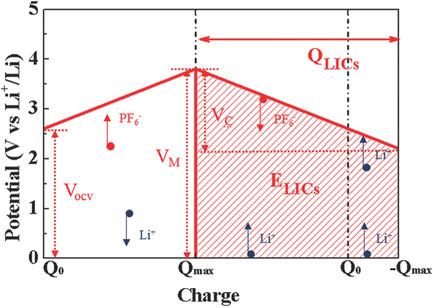当前位置:
X-MOL 学术
›
Adv. Mater.
›
论文详情
Our official English website, www.x-mol.net, welcomes your feedback! (Note: you will need to create a separate account there.)
Electrode Materials, Electrolytes, and Challenges in Nonaqueous Lithium‐Ion Capacitors
Advanced Materials ( IF 29.4 ) Pub Date : 2018-03-12 , DOI: 10.1002/adma.201705670 Bing Li 1 , Junsheng Zheng 1 , Hongyou Zhang 1 , Liming Jin 1 , Daijun Yang 1 , Hong Lv 1 , Chao Shen 2, 3 , Annadanesh Shellikeri 2, 3 , Yiran Zheng 1 , Ruiqi Gong 1 , Jim P. Zheng 1, 2, 3 , Cunman Zhang 1
Advanced Materials ( IF 29.4 ) Pub Date : 2018-03-12 , DOI: 10.1002/adma.201705670 Bing Li 1 , Junsheng Zheng 1 , Hongyou Zhang 1 , Liming Jin 1 , Daijun Yang 1 , Hong Lv 1 , Chao Shen 2, 3 , Annadanesh Shellikeri 2, 3 , Yiran Zheng 1 , Ruiqi Gong 1 , Jim P. Zheng 1, 2, 3 , Cunman Zhang 1
Affiliation

|
Among the various energy‐storage systems, lithium‐ion capacitors (LICs) are receiving intensive attention due to their high energy density, high power density, long lifetime, and good stability. As a hybrid of lithium‐ion batteries and supercapacitors, LICs are composed of a battery‐type electrode and a capacitor‐type electrode and can potentially combine the advantages of the high energy density of batteries and the large power density of capacitors. Here, the working principle of LICs is discussed, and the recent advances in LIC electrode materials, particularly activated carbon and lithium titanate, as well as in electrolyte development are reviewed. The charge‐storage mechanisms for intercalative pseudocapacitive behavior, battery behavior, and conventional pseudocapacitive behavior are classified and compared. Finally, the prospects and challenges associated with LICs are discussed. The overall aim is to provide deep insights into the LIC field for continuing research and development of second‐generation energy‐storage technologies.
中文翻译:

电极材料,电解质以及非水锂离子电容器的挑战
在各种储能系统中,锂离子电容器(LIC)由于具有高能量密度,高功率密度,长寿命和良好的稳定性而备受关注。作为锂离子电池和超级电容器的混合体,LIC由电池型电极和电容器型电极组成,可以潜在地结合电池高能量密度和电容器高功率密度的优点。这里,讨论了LIC的工作原理,并综述了LIC电极材料,特别是活性炭和钛酸锂,以及电解质开发方面的最新进展。对插入式伪电容行为,电池行为和常规伪电容行为的电荷存储机制进行了分类和比较。最后,讨论了与低收入国家相关的前景和挑战。总体目标是为LIC领域提供深入的见识,以继续研究和开发第二代储能技术。
更新日期:2018-03-12
中文翻译:

电极材料,电解质以及非水锂离子电容器的挑战
在各种储能系统中,锂离子电容器(LIC)由于具有高能量密度,高功率密度,长寿命和良好的稳定性而备受关注。作为锂离子电池和超级电容器的混合体,LIC由电池型电极和电容器型电极组成,可以潜在地结合电池高能量密度和电容器高功率密度的优点。这里,讨论了LIC的工作原理,并综述了LIC电极材料,特别是活性炭和钛酸锂,以及电解质开发方面的最新进展。对插入式伪电容行为,电池行为和常规伪电容行为的电荷存储机制进行了分类和比较。最后,讨论了与低收入国家相关的前景和挑战。总体目标是为LIC领域提供深入的见识,以继续研究和开发第二代储能技术。



























 京公网安备 11010802027423号
京公网安备 11010802027423号